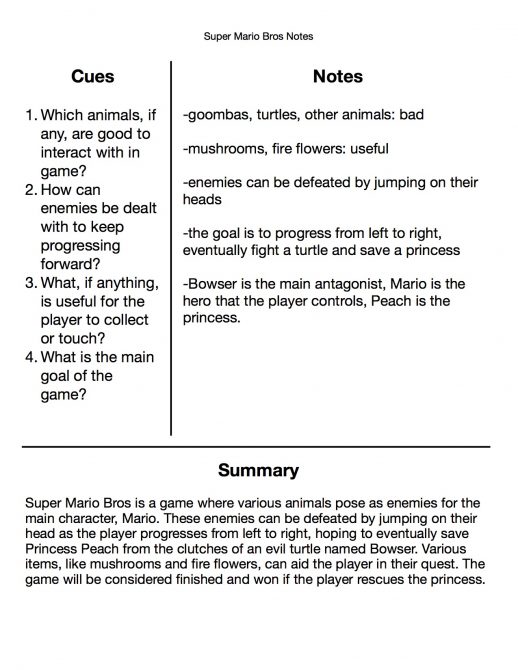Taking notes in class: this is sort of like the basic survival technique of a student. Small creatures forage for food on the forest floor, hiding it away for the winter. Just like them, students scrounge for knowledge in the vast, complicated environment of a three-hour lecture, saving up what little they can gather for exam season. To some extent, biology plays a role. Some animals are simply more able to survive in their environment. However, the amount of food collected can be the difference between life or death when winter comes. Don’t you want to have more knowledge saved up for this exam season than you did last time?
I never took good notes in school, if any at all. I would just sort of scribble down whatever I could get my head around in time to write down, and that was that. This meant that when exam season arrived, I had random pages of messy scribbles to deal with. Not the most useful. I wish I had known about The Cornell Method. Here’s a picture to help you visualize it, then I’ll break it down for you…

The method is simple: collect notes, use them to formulate memory recall cues or questions, reflect and summarize what you’ve learned. I’ll break that down for you, step by step:
Take Notes
Just take notes! Ok, it isn’t that simple, but it’s close. Pay attention in class or as you do a reading and try to figure out what is useful and what isn’t. Take down any facts, formulas, major points, anything that seems useful and like it might be on a test. Ignore things that seem unnecessary, extra, or just less important than something you’re already writing if you don’t have time for both. You know how to take good notes already, right?
Think of Cues
As soon as possible, like when you finish the chapter or once the lecture has finished, use your notes and the rest of your memories about what was just taught to think of some cues. Cues could be in question form, which will be useful when you want to study, or more general, something like, “the five steps to successful marketing”. The point of these cues is to give you some idea of what you should know without containing that information so that you can use them to study. Cover the notes section of your paper when you study and only look at the cues. Can you answer the questions? Do you know the specifics of each general topic? Are you ready to ace this test? This will help you figure that out.
Reflect and Summarize
At some later point, perhaps while you’re studying, try to make connections and summarize what you’ve learned. Use the cues to see if you’ve absorbed and understood the notes, and practice or review if you need to. Then, when you feel confident, try to write out what you now know that you didn’t know before. Make sure to draw connections and synthesize. If you can do this, you should be ready for the long answer exam questions that will ask you to do the same thing, in some way or another. Test yourself at home with no grades on the line to prepare for when it really matters!
So that’s the Cornell method. It’s much more organized than how I used to do things, when I did them, that is. So if you take messy notes, or don’t take notes at all, this should help you prepare for your tests. Take what notes you can, think of cues and questions to help you remember and engage with what was taught, then test yourself to make sure you can pull it all together when the time comes. Study smarter, not harder! Good luck out there, my friends. You can do this!

Take note: you could win $50,000 in student prizes
*Opinions expressed are those of the author, and not necessarily those of Student Life Network or their partners.




